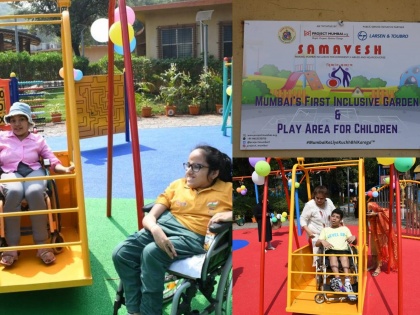BMC’s inclusivity project gets laurels, but yeh dil maange more
By Snehal Mutha | Published: December 29, 2023 08:24 PM2023-12-29T20:24:24+5:302023-12-29T20:28:39+5:30
Over 3 million people use the Mumbai suburban railway daily, a vibrant artery connecting Virar and Andheri. But for ...

BMC’s inclusivity project gets laurels, but yeh dil maange more
Over 3 million people use the Mumbai suburban railway daily, a vibrant artery connecting Virar and Andheri. But for Rajesh Patil, who uses crutches due to a disability, this journey is far from effortless. The designated spaces for disabled passengers in local trains often require a monumental struggle to reach, adding another layer of difficulty to his daily commute.
Patil's story highlights the challenges faced by people with disabilities in navigating Mumbai's infrastructure. He recalls numerous instances where inadequate infrastructure, like poorly maintained stairs and absent ramps, forced him to risk tripping in public spaces. "Sometimes, hawkers encroach upon the steps, leaving us with nowhere to go," he says, pointing to the disconnect between government initiatives and their practical implementation.
However, a glimmer of hope emerged recently with the Brihanmumbai Municipal Corporation's (BMC) announcement of the 'Samavesh' project. This initiative aims to create a more inclusive and accessible environment for people with disabilities, initially focusing on ten wards within Mumbai.
The project plans to address crucial problems like uneven staircases, missing ramps, and a lack of disability-friendly amenities like accessible washrooms and parking spaces. It also envisions incorporating at least one accessible municipal garden, school, hospital, and ward office in each targeted ward.
While the intention is laudable, concerns remain about the project's scope and implementation. Reshma Kadam, another individual with a disability, emphasizes the need for accessibility beyond gardens and parks. "I often visit the Divyang office, but without an elevator, accessing it is a struggle," she points out. She also highlights the lack of a ramp at the Azad Nagar Post Office, hindering her ability to access basic services.
Virali Modi, whose viral social media thread exposed the inaccessibility of the Khar Marriage Court, where she was forced to be carried for her wedding ceremony, expresses cautious optimism about Samavesh. She urges swift action, highlighting the lack of progress even three months after her complaint. When LokmatTimes.com visited the office to see what had changed after Modi’s complaint, we found there was just a hurriedly made ramp and nothing else. Even the washrooms are still inaccessible.
Modi emphasizes the need for comprehensive accessibility, encompassing not just destinations but also the journey itself. "Our roads are in terrible condition, causing many spinal cord injuries," she says, advocating for stricter traffic regulations and improved road infrastructure. Currently, no data exists on the accessibility of Mumbai's civic buildings and public infrastructure. The BMC aims to address this by collecting data before tackling the problem head-on. The project will initially be implemented in ten wards across the city – Colaba, Malabar Hill, Byculla, Mulund, Dadar, Kurla, Andheri East, Andheri West, Malad, and Khar. The BMC will partner with NGO Project Mumbai, who will provide expertise and support.
Project Mumbai founder Shishir Joshi outlines the project's five key pillars: recreational facilities, physical infrastructure improvements, digital accessibility for neurodiverse individuals, skills development and employment opportunities, and sensitivity training for BMC employees.
He acknowledges the delays caused by legal hurdles and uncertainties regarding guidelines and parameters. However, he expresses optimism, stating, "We've finally started, and our goal is to make all 24 wards inclusive within three years."
Patil, Kadam, and Modi's experiences exemplify the daily struggles faced by many people with disabilities in Mumbai. While the 'Samavesh' project offers a ray of hope, its success hinges on efficient implementation, addressing all accessibility gaps, and ensuring inclusivity not just in public spaces but also throughout the daily lives of people with disabilities.
Open in app

